Lisbon
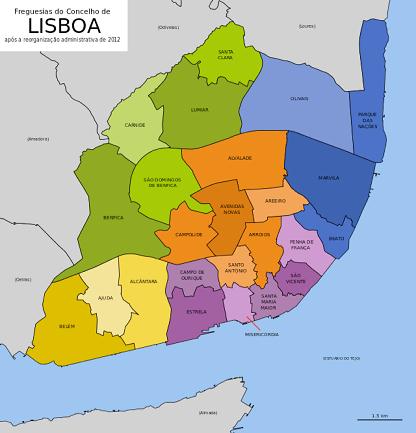
Population According to the most recent data of the National Statistics Institute (INE 2013), the total population living in Portugal is 10.427.301, of whom 4.958.020 are male and 5.469.281 female.
It is important to distinguish Lisbon city (Municipality) and Lisbon District or Region. According to the census data (2011) the city of Lisbon had 547.733 inhabitants, while the Region of Lisbon had 2.821.876. Our project takes the City of Lisbon, equivalent to the Municipality of Lisbon as the main bureaucratic organizational unit, thus from now on, we refer to it simply as Lisbon.
Lisbon parishes (Juntas de Freguesia) were recently reorganized by law 56/2012, so currently it has 24 parishes. The two territories selected for the UPWEB study are Lumiar and Santa Maria Maior (Mouraria).
Lisbon has a territory of 84,9 km2 and a density of 6.452 inhabitants per km2. There are 243.892 families, thus medium family size is 2,24. Out of the total population of 547.733, 130.960 people are 65 years of age or over, and 65.988 are 14 or younger.
Other population statistics include marriage rate which is 5,5% and divorce rate 2,2%. About 52% of birth are out of wedlock, while 28,9% of the marriages are Catholic. The proportion of marriages between Portuguese and a foreigner is high, about 29%, while for the country if about 12,2%.
Diversity
Lisbon presents the higher percentage of foreign population requesting residency, about 1,11 out of 100 people, equivalent to 5.884 in 2012, 2.848 men and 3.036 women. The total number of foreigners living in Lisbon is 44.367, reaching 203.565 if considering the Region of Lisbon. In any case, Brazilians constitute the largest immigrant community, representing 28% of all foreigners in Lisbon and about 30,6% in the Region of Lisbon.
Focusing in the city of Lisbon, after Brazilians, the most numerous foreign nationals are: Chinese, Cape Verdeans, Romanians, Ukrainians, Angolans and people from Guinea Bissau.
Economy
Regarding the labour market, the Region of Lisbon concentrates about 25% of the active population, with lower activity rate than the mean rate in the country, mainly in the population 45 years of age and over. On the other hand, about 25% of the population has also a college degree. Unemployment rate is higher in the Region of Lisbon than in the rest of the country, about 17,6% vs 15,7% for Portugal. Unemployment rates for youth and women are also higher, 43,8% for vs 37,7% and 15,8% and 15,6% respectively.
In the Region of Lisbon economic activities are concentrated in the tertiary sector where the majority of the employed population (82,7%) works, while the others sectors are distributed throughout industry (10,6%), civil construction (6%) and agriculture (0,72%).
The mean monthly earning of employees overall (for all types of business) reached about 1.084 euros for Portugal and 1.576 euros for Lisbon. However, minimum wage is 505 euros a month.
Social security
The annual average value of pensions in Lisbon are about 5.994 euros, while pensions for disability are 4.990 euros, for old age 6.939 euros and survival 3.615 euros. The average unemployment subsidy is 4.512 euros per year, and the average number of days in unemployment is about 222 per year. In 2012, there were 24.771 people getting unemployment benefits in Lisbon.
Housing Lisbon has 51.805 building for conventional family housing and 323.394 conventional family dwellings in 2012. Regarding social housing, Lisbon has a total of 4.761 buildings for subsidized rent, and a total of 26.625 dwellings, out of which 24.880 are rented, according to 2012 data. The number of new contracts reached only 209, while the average rent for social housing is 79 euros.
Health
Lisbon has a total of 36 hospitals, 19 public and 17 private, with 6.321 beds and 199 operating rooms. Total consultations for 2011 reached 3.686.965. Official clinics (health centres) reached 17, all of them without in-patient system, with a total staff of 1.258 people. Within the health centres, a total of 1.180.045 consultations were held. There are 286 pharmacies in Lisbon.
Mouraria
Mouraria is a neighbourhood located in the historical centre of Lisbon and its territory is part of one of the new parish Santa Maria Maior. Before, the neighbourhood included several parishes, but the political decision was the reorganization of bureaucratic-administrative units into larger territories, extinguishing the smaller ones.
Santa Maria Maior represents 2% of the territory of the city of Lisbon, with an area of 1,49 km² with a population of 12.976 residents (based on the census 2011). The population density is 8.699 inhabitants per km², which compared with the average for Portugal of 114,5 inhabitants/km² and Lisbon 6.448,2 inhabitants/km², it suggests a high population density area.
Housing
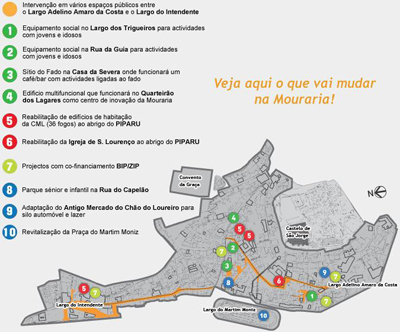
Santa Maria Maior has 10.787 of conventional family dwellings; 71,8% are rented. Rent cost varies, while about 1/3 pay 300€ or more, 1/4 pays 50€ or less. In Mouraria, in particular, 47% of tenants pay about 150€. Also, half of the tenants are economically inactive population, mainly retirees with state pensions. Buildings are very old, as the majority (66,7%) are from before 1945. Thus about 60% of the buildings need to be repaired. 9% of them are in advanced degradation and 1,4% needs to be demolished. In relation to Mouraria, the main housing problems are: need for rehabilitation (49%), housing degradation (10%) and accessibility (6%). There is a high level of housing inadequacy in occupation, while 48,9% of the dwellings are under crowded, 18,2% overcrowding.
Age
Overall, population in this district is aged, however if compared with the rest of the parish, has a higher percentage of younger population, mainly due to the children of immigrants.
Diversity
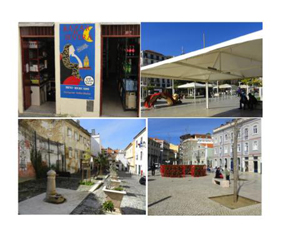 Mouraria hosts around 51 nationalities. Bangladeshis (23,3%) are the most represented nationality, followed by Indians (13,4%), Chinese (13,1%) and Brazilians (8,7%); 3,8% of the residents have dual citizenship. Foreign population increased 213,5% between the 2001 and 2011 census. Along with diversity in nationalities, come diversity in religion. Mouraria has a large Muslim population, and there is a Mosque although the conditions are very precarious. There are promises about constructing a new Mosque, in the new quarter/square named Transmouraria.
Mouraria hosts around 51 nationalities. Bangladeshis (23,3%) are the most represented nationality, followed by Indians (13,4%), Chinese (13,1%) and Brazilians (8,7%); 3,8% of the residents have dual citizenship. Foreign population increased 213,5% between the 2001 and 2011 census. Along with diversity in nationalities, come diversity in religion. Mouraria has a large Muslim population, and there is a Mosque although the conditions are very precarious. There are promises about constructing a new Mosque, in the new quarter/square named Transmouraria.
Education
With regards to education, 49,9% of the residents of Santa Maria Maior have completed 9th grade, but 2,5% of the youth between 15 and 29 have no completed any level of education. The illiteracy rate is 4,38%, with highest incidence in the female population (6,81%) and in Mouraria (5,65%). Mouraria has the highest proportion of residents with no education (41%).
Economy
The economic activity rate is 51,25%, higher from men (58,1%) than for women (44,22%). The livelihood of the population is attained by wages (50,1%) and pensions (30,9%). Unemployment rate it is around 13%, higher for men (14%) than for women (12,5%). Mouraria, however, has the highest percentage of unemployed residents (17,3%), mainly due to youth.
Health
Health services infrastructure from the National Health System includes two Hospitals (São José for emergency and Capuchos for speciality consultations). There are 3 Health centres serving the neighbours in Mouraria: São Nicolau, Graça e Penha de França. There is a Private Hospital (mutuality) in the neighbourhood (São Cristovão). The main health problems identified in the Social Diagnosis of Santa Maria Maior were:
- Aging and disability: 1.695 women and 897 men with mobility difficulties, 30,6% of them aged between 30 and 64 years old and 64,8% 65 years old and over. Main difficulties are related to physical limitations: vision, walk and climbing stairs, but also loneliness.
- Addictive behaviour: main problems include addition to psychoactive substances, alcohol abuse as well as substance abuse. Mouraria has the highest addictive behaviour.
- Psychiatric disorders tend to be related with the above problem.
One vulnerable population in Mouraria is composed by the homeless, with tend to present addictive behaviour and psychiatric disorders.
Lumiar
The parish of Lumiar was recently reorganized. It is one of the largest, occupying 8% of the City of Lisbon. Lumiar has an area of 6,57 km2, with a total population of 45.605 inhabitants, with a density of 6.941 inhabitants per km2. It is located in the North of Lisbon.
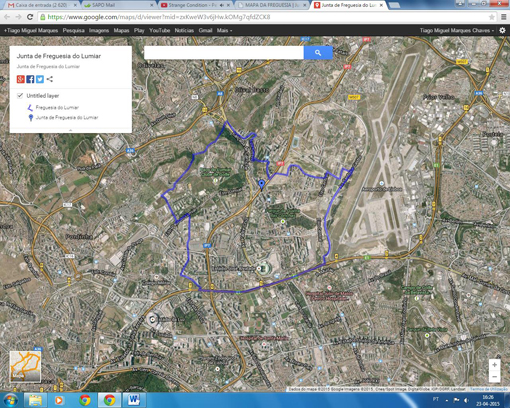
To organize the urbanization process of the territory, Alta de Lisboa was created in 1984, constituting the SGAL (Alta de Lisboa Management Company). This initiative aimed at creating housing, social and urban infrastructure promoting a social mixing approach in which social housing and luxury flats share a common space. This idea did not work as expected, though. Later, in 2005, a local group was created to promote community development in the territory, knows as GCAL or Community Group of Alta de Lisboa. Within the Alta de Lisboa, the UPWEB study will concentrate in the Red Cross Neighbourhood and its surroundings, contain in the Alta de Lisboa area. The 2012 bureaucratic & administrative reorganization split the territory of Alta de Lisboa in two parishes, Lumiar and Santa Clara, the later one hosts the poorest neighborhoods, although the community base group GCAL still serves both.
Population
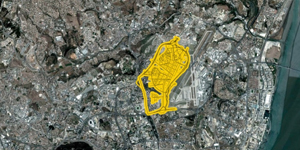 The population of Lumiar (45.605) is younger and better educated than in the rest of the city, 42% has a college degree. 36% of the residents are youth, 51% adults and 13% elderly. About 74% of the families do not have an elder living with them, thus aging rate is 96%. Only 2% of the residents are illiterate. These indicators are positively influenced by the well-off residents distributed across the territory.
The population of Lumiar (45.605) is younger and better educated than in the rest of the city, 42% has a college degree. 36% of the residents are youth, 51% adults and 13% elderly. About 74% of the families do not have an elder living with them, thus aging rate is 96%. Only 2% of the residents are illiterate. These indicators are positively influenced by the well-off residents distributed across the territory.
Housing
Most of the construction in Lumiar is recent, 42% built after 1991. Lumiar has 1.850 buildings and 23.382 conventional family dwellings; out of which 72% are owned by the occupants, and 22% are rented. About 58% of the buildings have 5 stories or more and only 25% 1 to 2 stories. Almost 70% of the dwellings have 3 or more bedrooms. One study indicates that 53,5% of tenants pay 99 euros or less for rent.
Alta de Lisboa holds Alto do Lumiar, the largest project of urbanization of Lisbon, with a planned capacity of over 50,000 inhabitants. The "Bairro da Cruz Vermelha" or Red Cross Neighbourhood, embedded in this initiative, is a social housing project built to house dislocated neighbours, as many families used to live in houses of illegal construction. The territory has been associated to social problems such as poverty, drug consumption and trafficking, with limited exchange with the more privilege neighbours.
Economy
The economic active population reaches 47,52% (21.672 individuals), most people’s source of income is employment, followed by pensions, retirement and incapacity payments. Other subsidies include child benefits and maintenance and survival payments, and tend to be more common in the Red Cross neighborhood. Unemployment rates varies depending on the source. In Lumiar, according to census data (2011) it was 8,9%, and for Alta de Lisboa 23,8% (CEDRU 2010), which seem to be contradictory.
Security issues
Security issues are related to crime taking place in vacant lots and uninhabited areas with poor maintenance such as weed growing and people throwing trash. These areas are used for drug consumption and trafficking, thus fostering insecurity and criminal activities, and also health associated risks.
Health issues
Health facilities in Lumiar are one public health centre (Lumiar) and one Public Hospital (Pulido Valente), although residents may use Hospital Santa Maria due to their residency. In Alta de Lisboa, 27,5% suffer from a condition that needs medical attention, 29,5% believe to had a bad state of health, and 21,2% of the families never take their children to the dentist.
Bad housing conditions are a risk for many residents of different ages, such as limited space, lack of air circulation, overcrowding, lack of accessibility for people with reduced mobility, among others, negatively influencing their health status, especially for the risk groups such as the elderly, the sick, the disabled and children. Some health conditions connected with poor housing conditions include joint and bone problems and respiratory diseases.
Diversity
There is not statistical date on diversity, however residents believe that the majority of the population is Portuguese, although there are residents of African origin living at the Red Cross neighborhood, mainly Cape Verdeans, Angolans, Mozambicans, among others. Thus most people speak Portuguese and some Creole. Most people are Catholic or of other Christian and Protestant creed.
A report suggests that people of immigrant background in Alta de Lisboa reaches 16,3% and that multicultural families (with one member being of foreign origin) reaches 17%.
Comparison between Mouraria (Santa Maria Maior) & Lumiar
One interesting fact is that while Santa Maria Maior is located in Baixa, Lumiar is located in Alta, that is, one is in the lands close to the river, the other is in the opposite direction, in the higher lands of Lisbon.